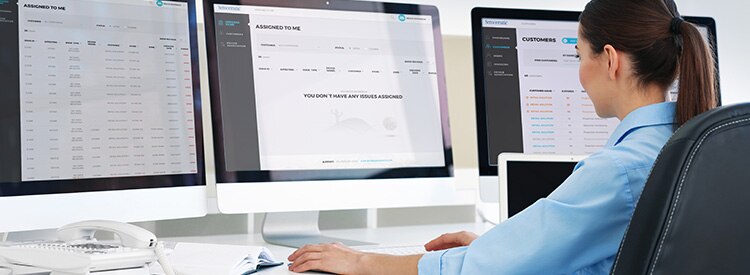Article
Four Steps to Better Store Loss Prevention

Today’s technology has revolutionised the shopping experience and when it comes to managing shrink in this always connected world, retailers need an effective loss prevention strategy that anticipates these changes ahead of the next tactic criminals will use to steal merchandise.
Advances in RFID, video analytics and big data have become the tools of choice for LP professionals who wish to increase their insight into the causes behind shrink.
The amount and quality of data available to retailers from these business tools reflects the needs of today’s complex retail environment.
Wardrobing, internal theft and receipt fraud are just a few methods criminals use to steal from retailers. These are specific patterns of criminal activity that need to be evaluated by incidence and flagged in order to create a picture of where, when and how shrink is occurring.
So, how can you really determine if your LP program is working for you? It all starts with knowing what’s really going on in your store.
Step One: Constructing a Foundation – Gather the Data
Retailers start collecting shopper data from the very minute they open their doors for business. They consistently compile statistics on employees, stock, transactions and shoppers.
In many cases, this information is readily available. In others, the retailers might not even be aware that the data already exists. The type of data gathered includes information and analysis about the occurrences of shrinkage and where security controls and technology are failing from common culprits of shrinkage such as employee theft, shoplifting, organised retail crime rings, administrative error, vendor/supplier fraud and return fraud.
For all these reasons, retailers and their loss prevention departments need to find smarter and better ways to identify the causes of shrink and recognise offender patterns to protect their merchandise and build a case against them. Loss prevention analytics technology can help.
Step two: Developing key performance indicators – Prioritise What to Measure
Over the past few years, retailers have started developing, tracking and measuring key performance indicators (KPIs) in a systematic approach to help reduce shrink. After analysing the data collected during Stage One, both the internal LP team and the LP solution provider have a better understanding of the company’s current state of shrinkage. The most effective KPIs help organisations by reducing the time required to identify new challenges for LP in the future. Loss Prevention analysis experts recommend focusing on only the top seven or eight in the beginning stages. Most KPIs require the use of company-wide data simultaneously.
Some defined KPIs include:
- Alarm Overview
- Alarms by Hour
- Alarm Rate by Traffic
- Shrink by Region
- Store Status Page
- Sensor Deactivations
- Organised Retail Crime Activity
Step Three: Understanding Trends and Developing Insights – Determine What it Means
Our loss prevention offerings are moving more closely to advances in next-generation business intelligence (BI) tools to better understand LP trends and evaluate insights. One of the initial uses of BI tools is leveraging them to generate massive volumes of compiled data, which then require an extensive manual evaluation by an in-house employee to determine what it all means. When it comes to internal theft for example, this would involve recognising trends of concealed fraud and evaluating statistics for consistent and inferred employee behaviour. One BI tool that is gaining momentum in the loss prevention space is Software as a Service or SaaS. For example, Sensormatic’s SMaaS platform or Shrink Management as a Service provides a cloud-based solution that can analyse detailed data with predictive analytics to identify and disrupt in-store shoplifting patterns. SMaaS is a smart technology that combines a defined set of KPIs based on district, region and enterprise to identify:
- Electronic Article Surveillance (EAS) effectiveness;
- Actionable loss prevention insights into shrink;
- Instantaneous correction of failing equipment;
- Exception email notifications; and can be integrated to scale with most legacy systems
Using next-generation LP technology via the cloud, there is no need to install analytics software on an internal server or rely on in-store Wi-Fi to operate. It also removes the need for costly licensing and the inefficiency and delay caused by installing software separately at each computer terminal. New releases are automatically updated when available so there is no need to install updates or security patches. It also requires limited IT staff because it is managed by an external data centre which can help reduce operational costs and more effectively correct equipment failures. It also simplifies and speeds up the reporting process and response time with an easy-to-use analytics dashboard.
Rather than creating vast reports filled with various statistics, metrics and activities, retailers can have a clear understanding of relevant metrics and insights. The dashboard can then summarise meaningful information to identify patterns across multiple locations, departments and products to tell the story about what’s happening in the store. Predictive analytics can be used to identify atypical correlations and patterns, specific data regarding employee overrides, sales-to-return ratios, on-hand stock quantity adjustments and the employee schedules of specific retail locations can trigger alerts to internal theft and questionable behaviour.
Step Four: Leveraging the Latest Technology – Modelling Solutions
The security and reliability of the cloud platform offers options for “as a service” solution models to simplify retail environments and gain the predictive and preventative insights to proactively manage shrink and work more effectively with law enforcement.
Instead of having to rely on the cycle counting to identify and resolve shrink-related concerns (which can take up to six months or more in many cases and significant investment in both employee effort and time). With predictive analytics technologies, retailers can capture relationships between multiple retail factors while interconnecting the related findings to past incidences of shrink.
Retailers can now make more timely, strategic and data-driven decisions to correct issues and reduce shrink.
Today’s retail store does a lot of talking all day long and will share information on how to minimise loss and maximise growth. All retailers must do is listen.
Learn more about smarter loss prevention solutions.
Explore Related Topics

Ready to see how Sensormatic Solutions can transform your bottom line?
Contact UsStay one step ahead with our articles, insights and latest news.
See more

Sensormatic News Desk

